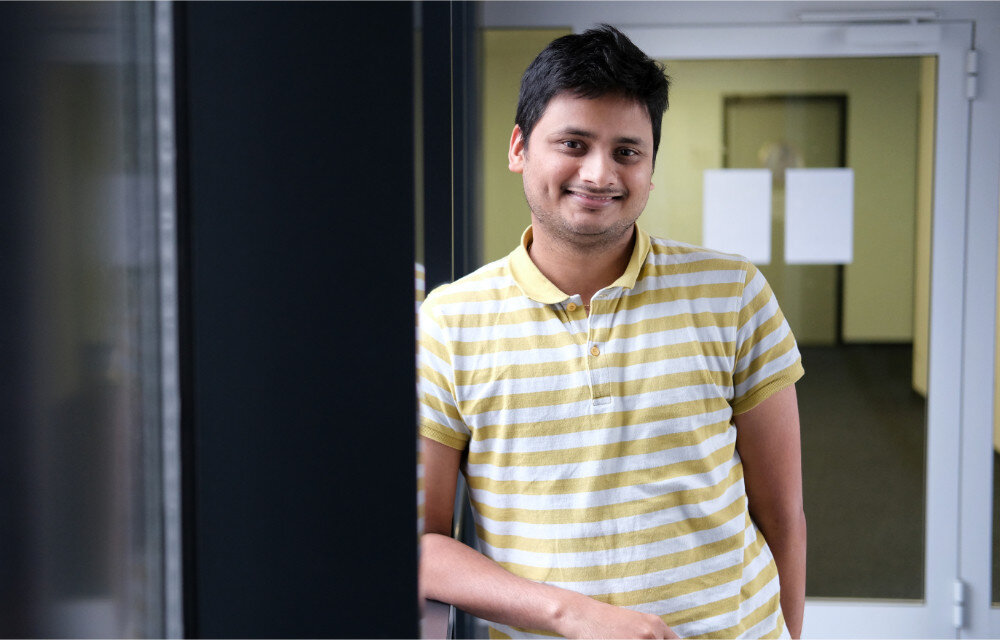Precisely measure bio-signals with just a few mouse clicks: Computer scientists facilitate the positioning of electrodes on the body

Aditya Shekhar Nittala, Doctoral Student in the Human Computer Interaction Lab at Saarland University. Photo: SIC/Philipp Zapf-Schramm
View all images
Many are familiar with it from medicine: To measure bio-signals such as the heartbeat or muscle contractions, sensor electrodes have to be placed on the skin. Until now, this has been a task for experts, because the quality of the measurements obtained depends largely on the correct positioning of these electrodes. Computer scientists at Saarland University have developed a method that automates this process for a specific body zone with just a few mouse clicks – and at the same time is faster and more accurate than any expert. They are now publishing their results in the internationally renowned journal Nature Communications.
Whether in sports, rehabilitation or for novel IT applications: Accurately recorded bio-signals like the heartbeat or muscle activity are important to measure performance, monitor health progress, and can even be used to control computers. Electrophysiological sensing electrodes which are attached to the skin can pick up these signals. “Manual placement of these electrodes requires anatomical knowledge and is based on a series of medical guidelines that describe where the best signals can be obtained” explains Aditya Shekhar Nittala, a doctoral student in Professor Jürgen Steimle’s research group on human-computer interaction at Saarland Informatics Campus.
Some applications have special requirements for the positioning of the sensor electrodes: In professional sports, for example, it may be necessary to record several bio-signals simultaneously in order to monitor training success without restricting the wearer’s freedom of movement. “In such a case, many different variables are interrelated, making it a major challenge even for experts to achieve good measurement results with a reasonable amount of time,” adds Aditya Nittala. As part of his doctoral thesis on computational design, he has now developed a method that, with just a few mouse clicks, can calculate an electrode layout in seconds to simultaneously measure muscle activity (EMG), skin conductivity (EDA), and the heartbeat (ECG) on the forearm.
Jürgen Steimle, professor of computer science at Saarland University and an expert in human-computer interaction, explains, “We show that an optimization approach can be employed for creating compact wearable devices that can measure multiple bio-signal modalities. The main contribution here not only lies in applying geometrical optimization for tackling the problem of electrode placement, but also in identifying, formalizing and integrating the set of rules that are inherent to electrode placement for sensing multiple modalities,” the professor adds. So far, the design approach only calculates electrode layouts for the forearm, since the researchers have been able to draw on a well-developed data base for this. Given the right data, the method could also be extended to other body regions.
The work entitled “Computational Design and Optimization of Electro-Physiological Sensors“ has now been published in the internationally renowned journal Nature Communications. In addition to Aditya Shekhar Nittala and professor Jürgen Steimle, Dr. Andreas Karrenbauer from the Saarbrücken based Max Planck Institute for Informatics and professor Tobias Kraus and Dr. Arshad Khan from the Leibniz Institute for New Materials (INM) in Saarbrücken were also involved. The tool was built on the input and evaluations of independent sports experts.
The new approach is complemented by the “PhysioSkin” project, which is also being developed in Jürgen Steimle’s group. “PhysioSkin” is a method by which ultra-thin, conductive tattoos can be produced using commercially available inkjet printers. By using the new tool to calculate the electrode layout on a computer and then printing it with “PhysioSkin,” prototypes for wearable electronic devices can be produced quickly and easily. For example, the researchers have developed a controller that recognizes muscle contractions as input signals and thus tracks how the user does push-ups.
Original publication:
Nittala, A.S., Karrenbauer, A., Khan, A. et al. Computational design and optimization of electro-physiological sensors. Nat Commun 12, 6351 (2021). https://doi.org/10.1038/s41467-021-26442-1
Project-website with demo video:
https://hci.cs.uni-saarland.de/projects/computational-design-of-physiological-sensors/
Further information:
https://www.nature.com/articles/s41467-021-26442-1
https://hci.cs.uni-saarland.de/projects/physioskin/
https://hci.cs.uni-saarland.de/
Questions can be directed at:
Prof. Dr. Jürgen Steimle
steimle@cs.uni-saarland.de
+49 (0)681 302 71080
Aditya Shekhar Nitalla (auf Englisch)
nittala@cs.uni-saarland.de
+49 681 302 71929
Background Saarland Informatics Campus:
800 scientists and about 2100 students from more than 80 nations make the Saarland Informatics Campus (SIC) one of the leading locations for computer science in Germany and Europe. Five world-renowned research institutes, namely the German Research Center for Artificial Intelligence (DFKI), the Max Planck Institute for Informatics, the Max Planck Institute for Software Systems, the Center for Bioinformatics and the Cluster for “Multimodal Computing and Interaction” as well as Saarland University with three departments and 24 degree programs cover the entire spectrum of computer science.
Editor:
Philipp Zapf-Schramm
Competence Center Computer Science
Saarland Informatics Campus
Phone: +49 681 302-70741
E-Mail: pzapf@mmci.uni-saarland.de
Press photos for download for use free of charge in connection with this press release:
 Aditya Shekhar Nittala, Doctoral Student in the Human Computer Interaction Lab at Saarland University. Photo: SIC/Philipp Zapf-Schramm
Aditya Shekhar Nittala, Doctoral Student in the Human Computer Interaction Lab at Saarland University. Photo: SIC/Philipp Zapf-SchrammDie Öffentlichkeitsarbeit am Saarland Informatics Campus wird unterstützt durch das Kompetenzzentrum Informatik Saarland, gefördert aus Mitteln des Europäischen Fonds für regionale Entwicklung (EFRE) und Mitteln der Staatskanzlei Saarland.


